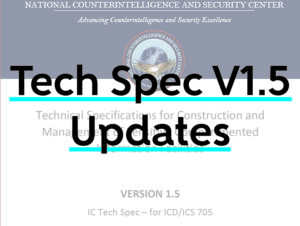Last week, the Office of the Director of National Intelligence released the long-awaited Version 1.5 of the “Technical Specifications for Construction and Management of Sensitive Compartmented Information Facilities,” commonly referred to as the “Tech Spec.” The document dictates how SCIFs/SAPFs are constructed both inside and outside the continental United States in order to earn government accreditation. The updates were based on feedback from PTSEWG (pronounced “PITS-wig”), a working group of industry professionals.
Here are the three Tech Spec 1.5 updates most relevant to Fixed Facility work in the U.S. and how they’ll impact SCIF/SAPF construction going forward.

Change #1: Secondary entrances
What changed: In Chapter 3, provisions and defined requirements were added for secondary entrance doors. Previously, a secondary day-time ingress/egress non-emergency door on a facility required special approval.
Our impressions: This significant revision is helpful for larger facilities with large workforces operating within them. Previously, without being able to have a secondary non-emergency ingress/egress door without special approval, facilities with a large volume of foot traffic had to funnel them all through the primary entrance, which could create a bottleneck effect. While the secondary entrance still requires AO approval, it will be something that gets approved more often in the future, thanks to this change. An additional benefit is that a secondary entrance allows for the number of use-cycles to be distributed across multiple doors, reducing the wear-and-tear effects on the primary entrance hardware, possibly extending their life and lowering maintenance costs.
Change #2: Pre-Construction Checklist
What changed: The pre-construction version of the Fixed Facility Checklist (FFC) was replaced with a Pre-Construction Checklist form.
Our impressions: Completing the pre-construction FFC from V1.4 was challenging because it was written as a final checklist document but was required to be completed prior to construction, creating disconnects in the type of information someone had to have in order to complete it. The new checklist accommodates a pre-construction reality and is much more efficient. Additionally, the checklist can now officially be submitted to either a Cognizant Security Authority (CSA) or the Accrediting Official (AO) for pre-construction approval, something not previously acknowledged in the Tech Spec.
Change #3: Compartmented Area (CA) types and Instructions for Co-Use Agreements
What changed: In Chapter 2, there are now three clearly defined category levels of CAs to be used and the respective security features that each needs to be approved. (A CA is an area within an accredited space that has physical and acoustic separation barriers in place so that a program different from the one that operates inside the accredited area could also be supported or in some cases operated long term. This allows for reciprocal/simultaneous use of a single facility for multiple programs without the government needing to issue and manage multiple facility ID numbers.) CAs require their own checklist for accreditation as well as the appropriate co-use agreements, instructions for which were added to Chapter 12.
Our impressions: This is a helpful addition to the Tech Spec because prior to this change, the requirements for CA approvals existed but lacked clear definition. The added CUA instructions clearly define reciprocity and provide definitive direction concerning reciprocity among all agencies that would/could need to co-utilize or share an accredited space. It further defines how CUAs are to be completed and managed.
Other Changes
Among the other Tech Spec 1.5 updates are new forms in Chapter 13 (including the Inspectable Materials Checklist and Pre-Construction Checklist), added applicability for OCONUS facilities, and added language regarding TSCM (technical surveillance counter-measures) services being restricted to U.S. government personnel or contractor personnel who have completed government-approved training. View the Tech Spec V1.5 here to review these changes.
To learn more about the construction of high-security facilities, check out our other blog posts, sign up for our free newsletter or register for our SCIF/SAPF Development Course.



